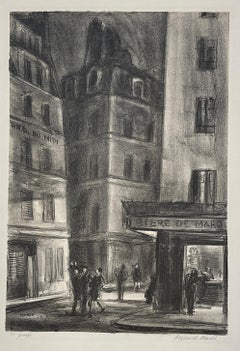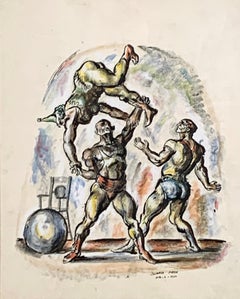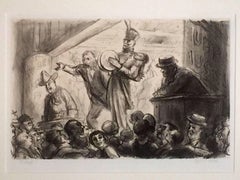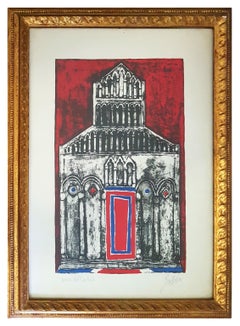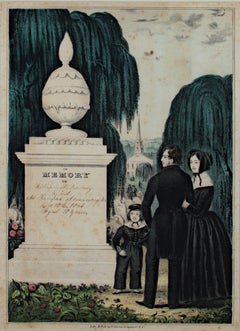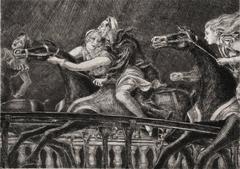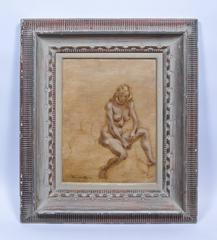1920s Art
to
1
13
2
4
3
1
4
2
Overall Height
to
Overall Width
to
2
1
11
6
6
5
5
3
2
1
1
1
1
1
1
1
1
1
1
1
1
69
13
33
8
11
70
75
60
35
33
6
4
4
3
1
Period: 1920s
Artist: Reginald Marsh
Watercolor Painting of the Monseigneur News Theatre, by Reginald Marsh, 1925
Located in New York, NY
Reginald Marsh, 1898 – 1954
Monseigneur News Theatre, 1925
Signed and dated at lower right: 'Reginald Marsh 1925'
Watercolor on card
8 x 11 inches
Born in Paris to parents who were American artists, Reginald Marsh became an adept illustrator at an early age. His family returned to the United States in 1900. Upon graduating from Yale University, Marsh moved to New York and in 1922 took a job as an illustrator at the New York Daily News. For the paper he provided cartoons of vaudeville and burlesque shows. In 1925 Marsh went to work for a new magazine -- The New Yorker -- as one of its original cartoonists. That same year he married Betty Burroughs, daughter of the paintings curator at the Metropolitan Museum of Art. Later that year they traveled to Europe where Marsh discovered the work of the old masters at the Louvre in Paris and British museums. With a sketchbook always on hand, he wandered the streets of Europe and began depicting bums or what he called figures of failure. Upon the couple’s return, Marsh, now with a serious interest in pursuing art, enrolled at the Art Students League where he studied under George Luks, John Sloan, and Kenneth Hayes Miller. This work, Monseigneur News Theatre, is accompanied by a letter from Marsh Scholar Professor Norman Sasowsky, University of Delaware...
Category
1920s Art
Materials
Watercolor
RUE ST. JACQUES
Located in Portland, ME
Marsh, Reginald (American, 1898-1954) RUE ST. JACQUES. S.5 Lithograph, 1928. Edition of 36 per Sasowsky, citing Marsh's notebook, but inscribed, lower left, "35 Proofs," and signed in pencil, lower right. 12 1/2 x 8 1/2 inches, 317 x 215 mm. (image). One of the series of lithographs...
Category
1920s Art
Materials
Lithograph, Alkyd
ACROBATS
Located in Portland, ME
Marsh, Reginald. ACROBATS. Ink, gouache, and pastel on paper, 1922. Signed, lower right. c. 18 1/2 x 14 1/2 inches; framed to 28 x 23 1/2 x 1 1/4 inches. In excellent condition.
Category
1920s Art
Materials
Ink, Pastel, Gouache
LONG ISLAND CITY
Located in Portland, ME
Marsh, Reginald. LONG ISLAND CITY. Watercolor and graphite on paper, 1929. Titled "Long Island City" and signed and dated, lower right. 14 x 20 inches...
Category
1920s Art
Materials
Watercolor
HUBER'S MUSEUM
Located in Portland, ME
Marsh, Reginald. HUBER'S MUSEUM. S.14. Lithograph, 1928. Edition of 36 impressions, according to Sasowsky, but inscribed "35 proofs, and signed in pencil. 8 3/4 x 13 1/2 inches, 222 ...
Category
1920s Art
Materials
Lithograph
Marsh, Reginald. TWO MODELS ON A BED
Located in Portland, ME
Marsh, Reginald. TWO MODELS ON A BED. Lithograph, 1928 (Sasowsky 9). 9 1/16" x 10 5/8." Signed in pencil and annotated "15 proofs." Only state. Excellent co...
Category
Ashcan School 1920s Art
Materials
Lithograph
Tank Car Rail
Located in New York, NY
Reginald Marsh (1898-1954), Tank Car Rail, 1929, etching, signed lower right and numbered 15 lower left margin [also signed and dated in the plate]. Reference: Sasowsky 86, fifth sta...
Category
American Realist 1920s Art
Materials
Etching
Two Models on a Bed
Located in New York, NY
Reginald Marsh (1898-1954), Two Models on a Bed, lithograph, 1928, signed and inscribed “15 proofs” [also initialed and dated in the plate]. Reference: Saso...
Category
American Impressionist 1920s Art
Materials
Lithograph
Irving Place Burlesque, lithograph, 1928
Located in New York, NY
Reginald Marsh (1898-1954), Irving Place Burlesque, lithograph, 1928, signed in pencil lower right and inscribed 25 proofs lower left margin [also signed and dated in the plate upper...
Category
American Impressionist 1920s Art
Materials
Lithograph
TWO GIRLS IN SUBWAY
Located in Portland, ME
Marsh, Reginald. TWO GIRLS IN SUBWAY. S.58. Etching, 1928.
Printed on cream-colored wove paper, with a watermark, upper left.
One of only two proofs of ...
Category
Ashcan School 1920s Art
Materials
Etching
St. Jean de Luz
Located in New York, NY
Reginald Marsh (1898-1954), St. Jean de Luz, lithograph, c. 1928, signed in pencil lower right and inscribed “40 proofs” lower left [also signed in the plate lo...
Category
Expressionist 1920s Art
Materials
Lithograph
Irving Place Burlesk
Located in New York, NY
Reginald Marsh (1898-1954), Irving Place Burlesk, etching, 1929, signed in pencil lower right and numbered (18) lower left. Reference: Sasowsky 75, third state (of 3). In very good c...
Category
American Realist 1920s Art
Materials
Etching
Loco-Erie Watering
Located in New York, NY
Reginald Marsh (1898-1954), Loco-Erie Watering, 1929, etching, signed in pencil lower right, and numbered (16) lower left. Reference: Sasowsky 85, fourth state (of 4). On Whatman pap...
Category
American Realist 1920s Art
Materials
Etching
Related Items
Cathedral - Lithograph by F. Gentilini
Located in Roma, IT
Cattedrale is an original lithograph realized by Franco Gentilini between 1940 and 1950. Hand signed in pencil on the lower right margin; "prova dell'artista", artist's proof. Perfec...
Category
Contemporary 1920s Art
Materials
Lithograph
'In Memory of William W. Peabody' original hand-colored lithograph by N. Currier
Located in Milwaukee, WI
The present hand-colored lithograph was produced as part of the funeral and mourning culture in the United States during the 19th century. Images like this were popular as ways of remembering loved ones, an alternative to portraiture of the deceased. This lithograph shows a man, woman and child in morning clothes next to an urn-topped stone monument. Behind are additional putto-topped headstones beneath weeping willows, with a steepled church beyond. The monument contains a space where a family could inscribe the name and death dates of a deceased loved one. In this case, it has been inscribed to a young Civil War soldier:
William W. Peabody
Died at Fairfax Seminary, VA
December 18th, 1864
Aged 18 years
The young Mr. Peabody probably died in service for the Union during the American Civil War. Farifax Seminary was a Union hospital and military headquarters in Alexandria, Virginia. The hospital served nearly two thousand soldiers during the war time. Five hundred were also buried on the Seminary's grounds.
13.75 x 9.5 inches, artwork
23 x 19 inches, frame
Published before 1864
Inscribed bottom center "Lith. & Pub. by N. Currier. 2 Spruce St. N.Y."
Framed to conservation standards using 100 percent rag matting and TruVue Conservation Clear glass, housed in a gold gilded moulding.
Nathaniel Currier was a tall introspective man with a melancholy nature. He could captivate people with his piercing stare or charm them with his sparkling blue eyes. Nathaniel was born in Roxbury, Massachusetts on March 27th, 1813, the second of four children. His parents, Nathaniel and Hannah Currier, were distant cousins who lived a humble yet spartan life. When Nathaniel was eight years old, tragedy struck. Nathaniel’s father unexpectedly passed away leaving Nathaniel and his eleven-year-old brother Lorenzo to provide for the family. In addition to their mother, Nathaniel and Lorenzo had to care for six-year-old sister Elizabeth and two-year-old brother Charles. Nathaniel worked a series of odd jobs to support the family, and at fifteen, he started what would become a life-long career when he apprenticed in the Boston lithography shop of William and John Pendleton.
A Bavarian gentleman named Alois Senefelder invented lithography just 30 years prior to young Nat Currier’s apprenticeship. While under the employ of the brothers Pendleton, Nat was taught the art of lithography by the firm’s chief printer, a French national named Dubois, who brought the lithography trade to America.
Lithography involves grinding a piece of limestone flat and smooth then drawing in mirror image on the stone with a special grease pencil. After the image is completed, the stone is etched with a solution of aqua fortis leaving the greased areas in slight relief. Water is then used to wet the stone and greased-ink is rolled onto the raised areas. Since grease and water do not mix, the greased-ink is repelled by the moisture on the stone and clings to the original grease pencil lines. The stone is then placed in a press and used as a printing block to impart black on white images to paper.
In 1833, now twenty-years old and an accomplished lithographer, Nat Currier left Boston and moved to Philadelphia to do contract work for M.E.D. Brown, a noted engraver and printer. With the promise of good money, Currier hired on to help Brown prepare lithographic stones of scientific images for the American Journal of Sciences and Arts. When Nat completed the contract work in 1834, he traveled to New York City to work once again for his mentor John Pendleton, who was now operating his own shop located at 137 Broadway. Soon after the reunion, Pendleton expressed an interest in returning to Boston and offered to sell his print shop to Currier. Young Nat did not have the financial resources to buy the shop, but being the resourceful type he found another local printer by the name of Stodart. Together they bought Pendleton’s business.
The firm ‘Currier & Stodart’ specialized in "job" printing. They produced many different types of printed items, most notably music manuscripts for local publishers. By 1835, Stodart was frustrated that the business was not making enough money and he ended the partnership, taking his investment with him. With little more than some lithographic stones, and a talent for his trade, twenty-two year old Nat Currier set up shop in a temporary office at 1 Wall Street in New York City. He named his new enterprise ‘N. Currier, Lithographer’
Nathaniel continued as a job printer and duplicated everything from music sheets to architectural plans. He experimented with portraits, disaster scenes and memorial prints, and any thing that he could sell to the public from tables in front of his shop. During 1835 he produced a disaster print Ruins of the Planter's Hotel, New Orleans, which fell at two O’clock on the Morning of the 15th of May 1835, burying 50 persons, 40 of whom Escaped with their Lives. The public had a thirst for newsworthy events, and newspapers of the day did not include pictures. By producing this print, Nat gave the public a new way to “see” the news. The print sold reasonably well, an important fact that was not lost on Currier.
Nat met and married Eliza Farnsworth in 1840. He also produced a print that same year titled Awful Conflagration of the Steamboat Lexington in Long Island Sound on Monday Evening, January 18, 1840, by which melancholy occurrence over One Hundred Persons Perished. This print sold out very quickly, and Currier was approached by an enterprising publication who contracted him to print a single sheet addition of their paper, the New York Sun. This single page paper is presumed to be the first illustrated newspaper ever published.
The success of the Lexington print launched his career nationally and put him in a position to finally lift his family up. In 1841, Nat and Eliza had their first child, a son they named Edward West Currier. That same year Nat hired his twenty-one year old brother Charles and taught him the lithography trade, he also hired his artistically inclined brother Lorenzo to travel out west and make sketches of the new frontier as material for future prints. Charles worked for the firm on and off over the years, and invented a new type of lithographic crayon which he patented and named the Crayola. Lorenzo continued selling sketches to Nat for the next few years.
In 1843, Nat and Eliza had a daughter, Eliza West Currier, but tragedy struck in early 1847 when their young daughter died from a prolonged illness. Nat and Eliza were grief stricken, and Eliza, driven by despair, gave up on life and passed away just four months after her daughter’s death.
The subject of Nat Currier’s artwork changed following the death of his wife and daughter, and he produced many memorial prints and sentimental prints during the late 1840s. The memorial prints generally depicted grief stricken families posed by gravestones (the stones were left blank so the purchasers could fill in the names of the dearly departed). The sentimental prints usually depicted idealized portraits of women and children, titled with popular Christian names of the day.
Late in 1847, Nat Currier married Lura Ormsbee, a friend of the family. Lura was a self-sufficient woman, and she immediately set out to help Nat raise six-year-old Edward and get their house in order. In 1849, Lura delivered a son, Walter Black Currier, but fate dealt them a blow when young Walter died one year later. While Nat and Lura were grieving the loss of their new son, word came from San Francisco that Nat’s brother Lorenzo had also passed away from a brief illness. Nat sank deeper into his natural quiet melancholy. Friends stopped by to console the couple, and Lura began to set an extra place at their table for these unexpected guests. She continued this tradition throughout their lives.
In 1852, Charles introduced a friend, James Merritt Ives, to Nat and suggested he hire him as a bookkeeper. Jim Ives was a native New Yorker born in 1824 and raised on the grounds of Bellevue Hospital where his father was employed as superintendent. Jim was a self-trained artist and professional bookkeeper. He was also a plump and jovial man, presenting the exact opposite image of his new boss.
Jim Ives met Charles Currier through Caroline Clark, the object of Jim’s affection. Caroline’s sister Elizabeth was married to Charles, and Caroline was a close friend of the Currier family. Jim eventually proposed marriage to Caroline and solicited an introduction to Nat Currier, through Charles, in hopes of securing a more stable income to support his future wife.
Ives quickly set out to improve and modernize his new employer’s bookkeeping methods. He reorganized the firm’s sizable inventory, and used his artistic skills to streamline the firm’s production methods. By 1857, Nathaniel had become so dependent on Jims’ skills and initiative that he offered him a full partnership in the firm and appointed him general manager. The two men chose the name ‘Currier & Ives’ for the new partnership, and became close friends.
Currier & Ives produced their prints in a building at 33 Spruce Street where they occupied the third, fourth and fifth floors. The third floor was devoted to the hand operated printing presses that were built by Nat's cousin, Cyrus Currier, at his shop Cyrus Currier & Sons in Newark, NJ. The fourth floor found the artists, lithographers and the stone grinders at work. The fifth floor housed the coloring department, and was one of the earliest production lines in the country. The colorists were generally immigrant girls, mostly German, who came to America with some formal artistic training. Each colorist was responsible for adding a single color to a print. As a colorist finished applying their color, the print was passed down the line to the next colorist to add their color. The colorists worked from a master print displayed above their table, which showed where the proper colors were to be placed. At the end of the table was a touch up artist who checked the prints for quality, touching-in areas that may have been missed as it passed down the line. During the Civil War, demand for prints became so great that coloring stencils were developed to speed up production.
Although most Currier & Ives prints were colored in house, some were sent out to contract artists. The rate Currier & Ives paid these artists for coloring work was one dollar per one hundred small folios (a penny a print) and one dollar per one dozen large folios. Currier & Ives also offered uncolored prints to dealers, with instructions (included on the price list) on how to 'prepare the prints for coloring.' In addition, schools could order uncolored prints from the firm’s catalogue to use in their painting classes.
Nathaniel Currier and James Merritt Ives attracted a wide circle of friends during their years in business. Some of their more famous acquaintances included Horace Greeley, Phineas T. Barnum, and the outspoken abolitionists Rev. Henry Ward, and John Greenleaf Whittier (the latter being a cousin of Mr. Currier).
Nat Currier and Jim Ives described their business as "Publishers of Cheap and Popular Pictures" and produced many categories of prints. These included Disaster Scenes, Sentimental Images, Sports, Humor, Hunting Scenes, Politics, Religion, City and Rural Scenes, Trains, Ships, Fire Fighters, Famous Race Horses, Historical Portraits, and just about any other topic that satisfied the general public's taste. In all, the firm produced in excess of 7500 different titles, totaling over one million prints produced from 1835 to 1907.
Nat Currier retired in 1880, and signed over his share of the firm to his son Edward. Nat died eight years later at his summer home 'Lion’s Gate' in Amesbury, Massachusetts. Jim Ives remained active in the firm until his death in 1895, when his share of the firm passed to his eldest son, Chauncey.
In 1902, faced will failing health from the ravages of Tuberculosis, Edward Currier sold his share of the firm to Chauncey Ives...
Category
Romantic 1920s Art
Materials
Lithograph, Watercolor
The Abduction of the Sabine Women , a Renaissance drawing by Biagio Pupini
Located in PARIS, FR
This vigorous drawing has long been attributed to Polidoro da Caravaggio: The Abduction of the Sabine Women is one of the scenes that Polidoro depicted between 1525 and 1527 on the façade of the Milesi Palazzo in Rome. However, the proximity to another drawing inspired by this same façade, kept at the Ecole des Beaux-Arts, and to other drawings inspired by Polidoro kept at the Musée du Louvre, leads us to propose an attribution to Biagio Pupini, a Bolognese artist whose life remains barely known, despite the abundant number of drawings attributed to him.
1. Biagio Pupini, a Bolognese artist in the light of the Roman Renaissance
The early life of Biagio Pupini, an important figure of the first half of the Cinquecento in Bologna - Vasari mentions him several times - is still poorly known. Neither his date of birth (probably around 1490-1495) nor his training are known. He is said to have been a pupil of Francesco Francia (1450 - 1517) and his name appears for the first time in 1511 in a contract with the painter Bagnacavallo (c. 1484 - 1542) for the frescoes of a church in Faenza. He then collaborated with Girolamo da Carpi, at San Michele in Bosco and at the villa of Belriguardo.
He must have gone to Rome for the first time with Bagnacavallo between 1511 and 1519. There he discovered the art of Raphael, with whom he might have worked, and that of Polidoro da Caravaggio. This first visit, and those that followed, were the occasion for an intense study of ancient and modern art, as illustrated by his abundant graphic production.
Polidoro da Caravaggio had a particular influence on the technique adopted by Pupini. Executed on coloured paper, his drawings generally combine pen, brown ink and wash with abundant highlights of white gouache, as in the drawing presented here.
2. The Abduction of the Sabine Women
Our drawing is an adaptation of a fresco painted between 1525 and 1527 by Polidoro da Caravaggio on the façade of the Milesi Palace in Rome. These painted façades were very famous from the moment they were painted and inspired many artists during their stay in Rome. These frescoes are now very deteriorated and difficult to see, as the palace is in a rather narrow street.
The episode of the abduction of the Sabine women (which appears in the centre of the photo above) is a historical theme that goes back to the origins of Rome and is recounted both by Titus Livius (Ab Urbe condita I,13), by Ovid (Fasti III, 199-228) and by Plutarch (II, Romulus 14-19). After killing his twin brother Romus, Romulus populates the city of Rome by opening it up to refugees and brigands and finds himself with an excess of men. Because of their reputation, none of the inhabitants of the neighbouring cities want to give them their daughters in marriage. The Romans then decide to invite their Sabine neighbours to a great feast during which they slaughter the Sabines and kidnap their daughters.
The engraving made by Giovanni Battista Gallestruzzi (1618 - 1677) around 1656-1658 gives us a good understanding of the Polidoro fresco, allowing us to see how Biagio Pupini reworked the scene to extract this dynamic group.
With a remarkable economy of means, Biagio Pupini takes over the left-hand side of the fresco and depicts in a very dense space two main groups, each consisting of a Roman and a Sabine, completed by a group of three soldiers in the background (which seems to differ quite significantly from Polidoro's composition).
The balance of the drawing is based on a very strongly structured composition. The drawing is organised around a median vertical axis, which runs along both the elbow of the kidnapped Sabine on the left and the foot of her captor, and the two main diagonals, reinforced by four secondary diagonals. This diamond-shaped structure creates an extremely dynamic space, in which centripetal movements (the legs of the Sabine on the right, the arm of the soldier on the back at the top right) and centrifugal movements (the arm of the kidnapper on the left and the legs of the Sabine he is carrying away, the arm of the Sabine on the right) oppose each other, giving the drawing the appearance of a whirlpool around a central point of support situated slightly to the left of the navel of the kidnapper on the right.
3. Polidoro da Caravaggio, and the decorations of Roman palaces
Polidoro da Caravaggio was a paradoxical artist who entered Raphael's (1483 - 1520) workshop at a very young age, when he oversaw the Lodges in the Vatican. Most of his Roman work, which was the peak of his career, has disappeared, as he specialised in facade painting, and yet these paintings, which are eminently visible in urban spaces, have influenced generations of artists who copied them abundantly during their visits to Rome.
Polidoro Caldara was born in Caravaggio around 1495-1500 (the birthplace of Michelangelo Merisi, known as Caravaggio, who was born there in 1571), some forty kilometres east of Milan. According to Vasari, he arrived as a mason on the Vatican's construction site and joined Raphael's workshop around 1517 (at the age of eighteen according to Vasari). This integration would have allowed Polidoro to work not only on the frescoes of the Lodges, but also on some of the frescoes of the Chambers, as well as on the flat of Cardinal Bibiena in the Vatican.
After Raphael's death in 1520, Polidoro worked first with Perin del Vaga before joining forces with Maturino of Florence (1490 - 1528), whom he had also known in Raphael's workshop. Together they specialised in the painting of palace façades. They were to produce some forty façades decorated with grisaille paintings imitating antique bas-reliefs.
The Sack of Rome in 1527, during which his friend Maturino was killed, led Polidoro to flee first to Naples (where he had already stayed in 1523), then to Messina. It was while he was preparing his return to the peninsula that he was murdered by one of his assistants, Tonno Calabrese, in 1543.
In his Vite, Vasari celebrated Polidoro as the greatest façade decorator of his time, noting that "there is no flat, palace, garden or villa in Rome that does not contain a work by Polidoro". Polidoro's facade decorations, most of which have disappeared as they were displayed in the open air, constitute the most important lost chapter of Roman art of the Cinquecento. The few surviving drawings of the painter can, however, give an idea of the original appearance of his murals and show that he was an artist of remarkable and highly original genius.
4. The façade of the Milesi Palace
Giovanni Antonio Milesi, who commissioned this palace, located not far from the Tiber, north of Piazza Navona, was a native of the Bergamo area, like Polidoro, with whom he maintained close friendly ties. Executed in the last years before the Sack of Rome, around 1526-1527, the decoration of Palazzo Milesi is considered Polidoro's greatest decorative success.
An engraving by Ernesto Maccari made at the end of the nineteenth century allows us to understand the general balance of this façade, which was still well preserved at the time. The frescoes were not entirely monochrome, but alternated elements in chiaroscuro simulating marble bas-reliefs and those in ochre simulating bronze and gold vases...
Category
Old Masters 1920s Art
Materials
Ink, Gouache, Pen
Miami Art Deco Pool, Blue Cyanotype on Paper, Abstract Shapes Water Reflections
By Kind of Cyan
Located in Barcelona, ES
This is an exclusive handprinted limited edition cyanotype.
"Miami Art Deco Pool" shows the movements of water over a tiled swimming pool floor.
Details:
+ Title: Miami Art Deco Poo...
Category
Abstract Geometric 1920s Art
Materials
Emulsion, Watercolor, Photographic Paper, C Print, Lithograph, Other Medium
Fine Antique French Impressionist Painting View Of A Park with Stone Urn
Located in Cirencester, Gloucestershire
The artist:
Henri Aime Duhem (1860-1941) French *see notes below, signed
Title: The Parkland
Medium:
signed gouache on paper, loosely laid over card, ...
Category
Impressionist 1920s Art
Materials
Gouache
Pacific Sunset Waves, Contemporary Cyanotype on Paper, Navy Blue, Beach House
By Kind of Cyan
Located in Barcelona, ES
This is an exclusive handprinted limited edition cyanotype.
"Pacific Sunset Waves" is an original cyanotype that abstractly shows the sunset reflections on the sea.
Details:
+ Titl...
Category
Realist 1920s Art
Materials
Emulsion, Mixed Media, Watercolor, Photographic Paper, Lithograph, Monop...
No Reserve
H 28 in W 40 in
“Flower Picking”
Located in Southampton, NY
Beautifully executed original hand colored lithograph using gouache and watercolor. Scene in Surrey, England. Signedxwith monogram in plate lower left, Myles Birket Foster. Published by M. H. Long. Condition is very good. In original 2 inch wide birdseye maple antique frame with thick museum mat with gold innner edge. Overall 22 by 26 inches.
Biography
Myles Birket Foster (4 February 1825 – 27 March 1899) was a popular English illustrator, watercolour artist and engraver in the Victorian period. His name is also to be found as Myles Birkett Foster.
Life and work
Foster was born in North Shields, England of a primarily Quaker family, but his family moved south to London in 1830, where his father founded M. B. Foster & sons — a successful beer-bottling company. He was schooled at Hitchin, Hertfordshire and on leaving initially went into his father's business. However, noticing his talent for art, his father secured an apprenticeship with the notable wood engraver, Ebenezer Landells, where he worked on illustrations for Punch magazine and the Illustrated London News.
On leaving Landells' employ, he continued to produce work for the Illustrated London News and the Illustrated London Almanack. He also found work as a book illustrator and, during the 1850s, trained himself to paint in watercolours. His illustrations of Longfellow’s Evangeline and books of poetry by other contemporaries were a great success, and he quickly became a successful artist in watercolours. Birket Foster became an Associate of the "Old" Watercolour Society (Later the Royal Watercolour Society) in 1860 and exhibited some 400 of his paintings at the Royal Academy over more than 2 decades.
Birket Foster travelled widely, painting the countryside around Scotland, the Rhine Valley, the Swiss lakes and in Italy, especially Venice. In 1863 he moved to Witley, near Godalming in Surrey where he had a house ("The Hill") built. Being friendly with Edward Burne-Jones and William Morris, he had the house decorated and furnished in contemporary style, with tiles and paintings by Burne-Jones and Morris' firm, Morris and Company. The same year he published a volume of "English Landscapes," with text by Tom Taylor...
Category
Impressionist 1920s Art
Materials
Lithograph, Watercolor, Gouache
Vérité (Truth) /// French Modern Impressionist Art Lithograph Nude Figurative
Located in Saint Augustine, FL
Artist: Henri Fantin-Latour (French, 1836-1904)
Title: "Vérité (Truth)"
Portfolio: Revue de l'Art Ancien & Moderne
*Issued unsigned
Year: 1900 (third state of three)
Medium: Original Lithograph on chine appliqué on wove paper
Limited edition: Unknown
Printer: A. Clot, Paris, France
Publisher: Revue de l'Art Ancien & Moderne, Paris, France
Reference: Floury No. 156; Hediard-Mason No. 156; L No. 139
Sheet size: 11.5" x 8.5"
Image size: 7.5" x 5.5"
Condition: In excellent condition
This review was founded in 1897 in the continuity of the review Les Beaux-Arts published between 1861 and 1865; Jules Comte, the founder, entitled his first issue Les Beaux-Arts - Revue nouvelle then changed the title to La Revue de l'art ancien et moderne. Jules Comte directed the review until his death in 1912. Raymond Woog took over , who was provisional director until the start of the war in July 1914. In 1919, André Dezarrois took over this review and was its director until December 1937, date of last issue (published in January 1938). In the meantime, it publishes the Bulletin of ancient and modern art, which has gained a certain notoriety in the community.
Biography:
Henri Fantin-Latour, in full Ignace-Henri-Jean-Théodore Fantin-Latour (born Jan. 14, 1836, Grenoble, France—died Aug. 25, 1904, Buré), French painter, printmaker, and illustrator noted for his still lifes with flowers and his portraits, especially group compositions, of contemporary French celebrities in the arts.
Fantin-Latour’s first teacher was his father, a well-known portrait painter. Later, he studied at the school of Lecoq de Boisbaudran and attended the École des Beaux-Arts. He exhibited at the official French Salons, but in 1863 he also showed his work in the rebel Salon des Refusés.
Although academic in manner, Fantin-Latour was independent in style. He had numerous friends among the leading French painters of his day, including J.-A.-D. Ingres, Eugène Delacroix, Camille Corot, Édouard Manet, and Gustave Courbet. His portrait groups, often arranged in rows of heads and figures like 17th-century Dutch guild...
Category
Impressionist 1920s Art
Materials
Lithograph
Chez Maxim's
By André Meurice
Located in London, GB
'Chez Maxim's', pastel and gouache on fine art paper, by André Meurice (circa 1950s - 60s). The artist depicts the glamorous clientele at the entryway to...
Category
Art Nouveau 1920s Art
Materials
Pastel, Gouache
Tomato Catsup, A.C. Annie, Lola Cola, Tobacco Red
By Mel Ramos
Located in Palm Desert, CA
Four prints by Mel Ramos. “Tomato Catsup, A.C. Annie, Lola Cola,” and “Tobacco Red” are pop art, offset lithographs in a palette of yellows, orange, and pink by the playful Mel Ramos. The artwork is signed in pencil in the lower right of each print, “Mel Ramos 72.” Framed dimensions are 37 x 31 5/8 x 1 7/8 inches each.
Mel Ramos is a California based Pop artist best known for his paintings of superheroes and female nudes, including Marilyn Monroe and Scarlet Johansson, with pop culture imagery. Many of his subjects emerge from Chiquita bananas...
Category
Pop Art 1920s Art
Materials
Lithograph
Kunsthandel Wolfgang Werner KG (Nudes) /// German Expressionism Schmidt-Rottluff
Located in Saint Augustine, FL
Artist: (after) Karl Schmidt-Rottluff (German, 1884-1976)
Title: "Kunsthandel Wolfgang Werner KG (Nudes)"
Year: 1984
Medium: Original Offset-Lithograph, Exhibition Poster on yellow wove paper
Limited edition: Unknown
Printer: Unknown
Publisher: Kunsthandel Wolfgang Werner KG, Bremen, Germany
Framing: Recently framed in a contemporary black moulding with frame space
Framed size: 29.25" x 19.5"
Sheet size: 27.25" x 17.75"
Image size: 9.5" x 12"
Condition: In excellent condition
Extremely rare
Notes:
Poster produced for a special posthumous exhibition of Rottluff's early watercolors and printmaking "Schmidt Rottluff" at Kunsthandel Wolfgang Werner KG, Bremen, Germany from March 8 - May 12, 1984, in tribute to the artist's, would have been, 100th birthday.
GIA Gallery Poster Disclaimer:
Not to be confused with thousands of contemporary inkjet/giclée/digital reproductions ignorantly or deliberately passed off as originals on the market today. The examples we offer here are the original period vintage (exhibition) posters, created and designed by, or under the supervision and authorization of the artist or their respective estate (posthumously), for various exhibitions and events in which they participated. If applicable, this poster is also fully documented within its respective artists' official catalogue raisonné of authentic graphic works, prints, and or posters.
Biography:
Karl Schmidt-Rottluff (born December 1, 1884, Rottluff, near Chemnitz, Germany—died August 9, 1976, West Berlin [now Berlin]), German painter and printmaker who was noted for his Expressionist landscapes and nudes.
In 1905 Schmidt-Rottluff began to study architecture in Dresden, Germany, where he and his friend Erich Heckel met Ernst Ludwig Kirchner and Fritz Bleyl, two other architecture students who shared their passion for painting. Together they formed the organization of Expressionist artists known as Die Brücke...
Category
Expressionist 1920s Art
Materials
Lithograph, Offset
“Tending the Sheep”
Located in Southampton, NY
Beautifully executed original hand colored lithograph using gouache and watercolor. Scene in Surrey, England. Signedxwith monogram in plate lower left, Myles Birket Foster. Published by M. H. Long. Condition is very good. In original 2 inch wide birdseye maple antique frame with thick museum mat with gold innner edge. Overall 22 by 26 inches.
Biography
Myles Birket Foster (4 February 1825 – 27 March 1899) was a popular English illustrator, watercolour artist and engraver in the Victorian period. His name is also to be found as Myles Birkett Foster.
Life and work
Foster was born in North Shields, England of a primarily Quaker family, but his family moved south to London in 1830, where his father founded M. B. Foster & sons — a successful beer-bottling company. He was schooled at Hitchin, Hertfordshire and on leaving initially went into his father's business. However, noticing his talent for art, his father secured an apprenticeship with the notable wood engraver, Ebenezer Landells, where he worked on illustrations for Punch magazine and the Illustrated London News.
On leaving Landells' employ, he continued to produce work for the Illustrated London News and the Illustrated London Almanack. He also found work as a book illustrator and, during the 1850s, trained himself to paint in watercolours. His illustrations of Longfellow’s Evangeline and books of poetry by other contemporaries were a great success, and he quickly became a successful artist in watercolours. Birket Foster became an Associate of the "Old" Watercolour Society (Later the Royal Watercolour Society) in 1860 and exhibited some 400 of his paintings at the Royal Academy over more than 2 decades.
Birket Foster travelled widely, painting the countryside around Scotland, the Rhine Valley, the Swiss lakes and in Italy, especially Venice. In 1863 he moved to Witley, near Godalming in Surrey where he had a house ("The Hill") built. Being friendly with Edward Burne-Jones and William Morris, he had the house decorated and furnished in contemporary style, with tiles and paintings by Burne-Jones and Morris' firm, Morris and Company. The same year he published a volume of "English Landscapes," with text by Tom Taylor...
Category
Impressionist 1920s Art
Materials
Watercolor, Gouache, Lithograph
Previously Available Items
Steeplechase
Located in Storrs, CT
Steeplechase. July 18, 1932. Etching. Sasowsky 138.x. 8 x 11 (sheet 13 x 15 1/2). Proof #18 from the 1969 posthumous edition of 100 for the Whitney Museum (there were about 10 lifeti...
Category
American Modern 1920s Art
Materials
Etching
Nude Portrait
Located in Buffalo, NY
An original tempera on board by Reginald Marsh (1898-1954). Finely painted and housed in a period modernist frame. Signed lower right, "Reginald Marsh". Image size, 12&q...
Category
American Modern 1920s Art
Materials
Oil, Tempera
Locomotive
Located in New York, NY
Signed and dated lower right: Reginald Marsh 1929
Category
Modern 1920s Art
Materials
Paper, Pencil, Watercolor
Erie R.R. and Factories
Located in Fairlawn, OH
Signed in pencil lower right; Numbered '38' lower left; Inscribed 'for Isabel Bishop'
Provenance:
Midtown Payson Galleries, NY (label verso)
Hobe Sound Galleries North, Brunswick,...
Category
1920s Art
Materials
Etching

